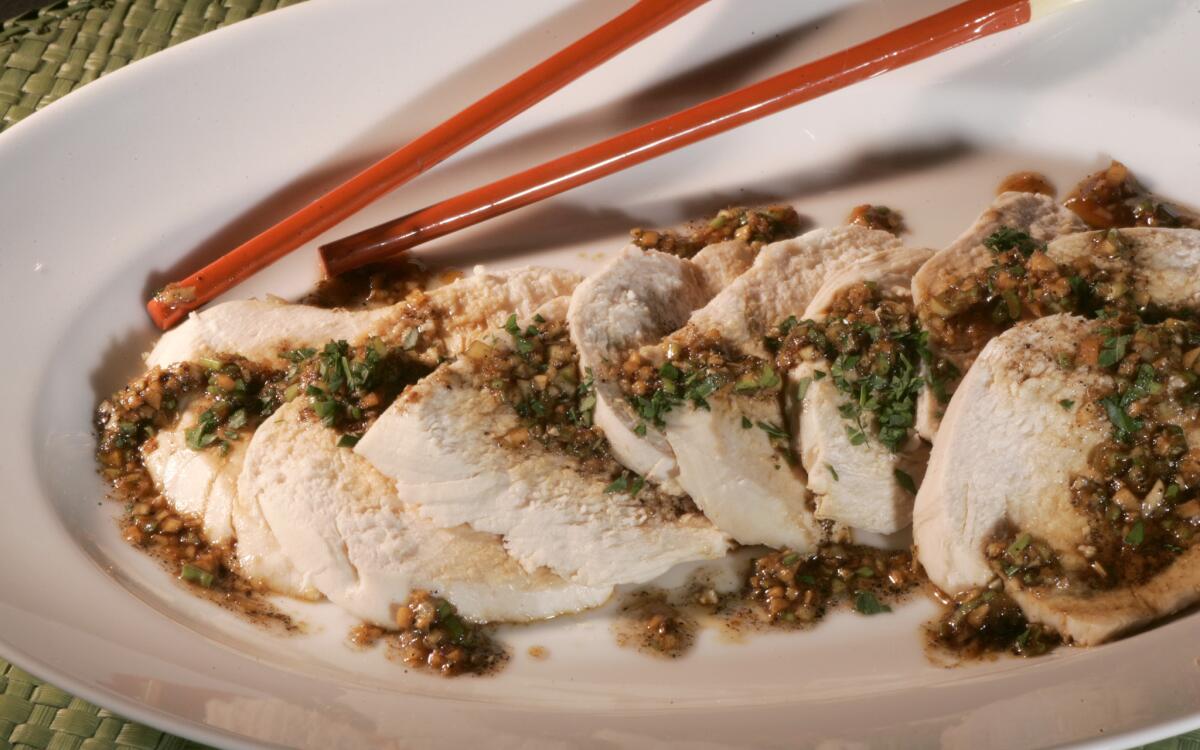Cold chicken slices with sesame and Sichuan pepper

There were days a couple of years ago when you might have spotted Lee Hefter, executive chef of Spago Beverly Hills, prowling through shops in Chinatown searching for an ingredient that then was almost impossible to find -- Sichuan peppercorns.
Hefter wanted the aromatic, camphor-scented spice because it imparts a unique and elusive fragrance and a mysterious flavor note to the Chinese-style dishes that he makes from time to time.
The problem was, Sichuan peppercorns had been banned in the United States. The ban was imposed because the tree from which they’re harvested, a citrus-family tree whose name translates as prickly ash, carries pests that could infect U.S. orchards, according to the Animal and Plant Health Inspection Service of the U.S. Department of Agriculture.
Despite the ban, stray packages turned up on store shelves until two or three years ago, when suddenly they vanished, seemingly for good.
Hefter gathered what he could in Chinatown here and hunted in Chinatowns elsewhere. “I remember there was a period of time when we were without them,” he says. What did he use instead when he couldn’t get Sichuan pepper? He simply changed his recipes. The taste of Sichuan pepper is unique. “You either have it, or you don’t. You don’t substitute for it,” he says.
Now Hefter has all the Sichuan peppercorns he could possibly want.
About two years ago, it was found that heating the peppercorns to 140 degrees made them safe enough to import. Roasted before they enter the United States and accompanied by a document verifying the process, the peppercorns are freely imported. You can now find them at almost any Asian market in the San Gabriel Valley and also at specialty cooking shops such as Le Sanctuaire in Santa Monica and Penzeys Spices in Torrance.
Ordinary peppercorns are Piper nigrum. The botanic name for Sichuan pepper is Zanthoxylum simulans. It’s the fruit of a prickly ash tree that grows in Sichuan province in China. The flavor is different if the tree is grown elsewhere, purists say.
*
Getting the name right
ASK for Sichuan peppercorns in an Asian shop, and you’re likely to draw a blank stare. To find them, you may have to use the Chinese names: hua jiao (Mandarin) and faa jiu (Cantonese). The labeling on the package varies too. “Dried prickly ash,” “dehydrated prickly ash” and “dried pepper” are some of the English names used. You can quickly recognize the peppercorns, though. They are tiny reddish shells, each containing a small black seed.
Why all the fuss over what seems an obscure seasoning? Because the flavor is so unusual, with a delicate nuance of camphor and what Hefter characterizes as a “lemony overtone.”
Assured of a regular supply, Hefter has been able to put dishes such as honey-lacquered squab on the menu. This sweet-spicy dish features Sichuan pepper-salt, which Hefter makes by grinding together four parts kosher salt to one part Sichuan peppercorns. Hefter learned about the roasted pepper-salt when working with the late Barbara Tropp at China Moon Cafe in San Francisco in the early ‘90s. He uses the blend when he wants to add complexity, especially to meat dishes.
Luis Diaz, executive chef of Chinois on Main in Santa Monica, uses the spice in a grilled New York steak dish. The steak is marinated in a ginger-garlic-hot chile mixture, then, while grilling, Diaz sprinkles the steak with Sichuan pepper. Although he calls the dish Sichuan beef, it’s quite mild. “It’s one of the classic dishes we have here,” he says.
Chinese food authority and author Carl Chu says the combination of hot chiles and the haunting, sensual flavor of Sichuan pepper produces a “numbing” effect that is the “distinguishing mark of Sichuan cuisine.”
“The flavor is so intoxicating, people get hooked on it,” he says.
But not all authentic Sichuan dishes are fiery, and some featuring Sichuan pepper don’t call for hot chiles. A cold chicken preparation adapted from Robert A. Delfs’ “The Good Food of Szechwan” combines the ground aromatic peppercorns with that everyday Asian quartet of ginger, soy sauce, rice vinegar and sesame oil to make an enchantingly fragrant sauce that transmutes a simple poached chicken breast into a tantalizing and memorable delicacy.
Place the chicken in enough boiling water in a wok or pot to cover the chicken. Turn down heat and simmer until tender but not overdone, about 17 to 20 minutes. Remove the chicken, drain and allow to cool completely.
Combine the green onion, ginger, soy sauce, vinegar, sesame oil, Sichuan pepper and sugar in a bowl.
Cut the cooled chicken into thin slices and arrange attractively on a serving platter. Pour the seasonings over the chicken slices and garnish with parsley. Serve at room temperature.
Get our Cooking newsletter.
Your roundup of inspiring recipes and kitchen tricks.
You may occasionally receive promotional content from the Los Angeles Times.















